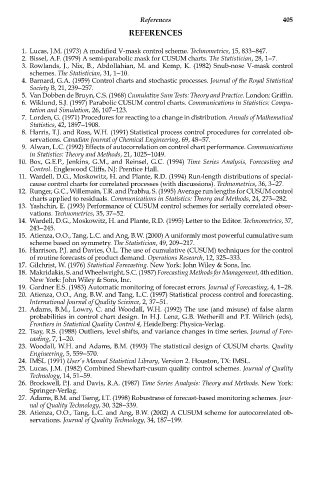Page 420 - Six Sigma Advanced Tools for Black Belts and Master Black Belts
P. 420
OTE/SPH
OTE/SPH
3:9
August 31, 2006
Char Count= 0
JWBK119-25
References 405
REFERENCES
1. Lucas, J.M. (1973) A modified V-mask control scheme. Technometrics, 15, 833--847.
2. Bissel, A.F. (1979) A semi-parabolic mask for CUSUM charts. The Statistician, 28, 1--7.
3. Rowlands, J., Nix, B., Abdollahian, M. and Kemp, K. (1982) Snub-nose V-mask control
schemes. The Statistician, 31, 1--10.
4. Barnard, G.A. (1959) Control charts and stochastic processes. Journal of the Royal Statistical
Society B, 21, 239--257.
5. Van Dobben de Bruyn, C.S. (1968) Cumulative Sum Tests: Theory and Practice. London: Griffin.
6. Wiklund, S.J. (1997) Parabolic CUSUM control charts. Communications in Statistics: Compu-
tation and Simulation, 26, 107--123.
7. Lorden, G. (1971) Procedures for reacting to a change in distribution. Annals of Mathematical
Statistics, 42, 1897--1908.
8. Harris, T.J. and Ross, W.H. (1991) Statistical process control procedures for correlated ob-
servations. Canadian Journal of Chemical Engineering, 69, 48--57.
9. Alwan, L.C. (1992) Effects of autocorrelation on control chart performance. Communications
in Statistics: Theory and Methods, 21, 1025--1049.
10. Box, G.E.P., Jenkins, G.M., and Reinsel, G.C. (1994) Time Series Analysis, Forecasting and
Control. Englewood Cliffs, NJ: Prentice Hall.
11. Wardell, D.G., Moskowitz, H. and Plante, R.D. (1994) Run-length distributions of special-
cause control charts for correlated processes (with discussions). Technometrics, 36, 3--27.
12. Runger, G.C., Willemain, T.R. and Prabhu, S. (1995) Average run lengths for CUSUM control
charts applied to residuals. Communications in Statistics: Theory and Methods, 24, 273--282.
13. Yashchin, E. (1993) Performance of CUSUM control schemes for serially correlated obser-
vations. Technometrics, 35, 37--52.
14. Wardell, D.G., Moskowitz, H. and Plante, R.D. (1995) Letter to the Editor. Technometrics, 37,
243--245.
15. Atienza, O.O., Tang, L.C. and Ang, B.W. (2000) A uniformly most powerful cumulative sum
scheme based on symmetry. The Statistician, 49, 209--217.
16. Harrison, P.J. and Davies, O.L. The use of cumulative (CUSUM) techniques for the control
of routine forecasts of product demand. Operations Research, 12, 325--333.
17. Gilchrist, W. (1976) Statistical Forecasting. New York: John Wiley & Sons, Inc.
18. Makridakis, S. and Wheelwright, S.C. (1987) Forecasting Methods for Management, 4th edition.
New York: John Wiley & Sons, Inc.
19. Gardner E.S. (1983) Automatic monitoring of forecast errors. Journal of Forecasting, 4, 1--28.
20. Atienza, O.O., Ang, B.W. and Tang, L.C. (1997) Statistical process control and forecasting.
International Journal of Quality Scieince, 2, 37--51.
21. Adams, B.M., Lowry, C. and Woodall, W.H. (1992) The use (and misuse) of false alarm
probabilities in control chart design. In H.J. Lenz, G.B. Wetherill and P.T. Wilrich (eds),
Frontiers in Statistical Quality Control 4, Heidelberg: Physica-Verlag.
22. Tsay, R.S. (1988) Outliers, level shifts, and variance changes in time series. Journal of Fore-
casting, 7, 1--20.
23. Woodall, W.H. and Adams, B.M. (1993) The statistical design of CUSUM charts. Quality
Engineering, 5, 559--570.
24. IMSL (1991) User’s Manual Statistical Library, Version 2. Houston, TX: IMSL.
25. Lucas, J.M. (1982) Combined Shewhart-cusum quality control schemes. Journal of Quality
Technology, 14, 51--59.
26. Brockwell, P.J. and Davis, R.A. (1987) Time Series Analysis: Theory and Methods. New York:
Springer-Verlag.
27. Adams, B.M. and Tseng, I.T. (1998) Robustness of forecast-based monitoring schemes. Jour-
nal of Quality Technology, 30, 328--339.
28. Atienza, O.O., Tang, L.C. and Ang, B.W. (2002) A CUSUM scheme for autocorrelated ob-
servations. Journal of Quality Technology, 34, 187--199.

